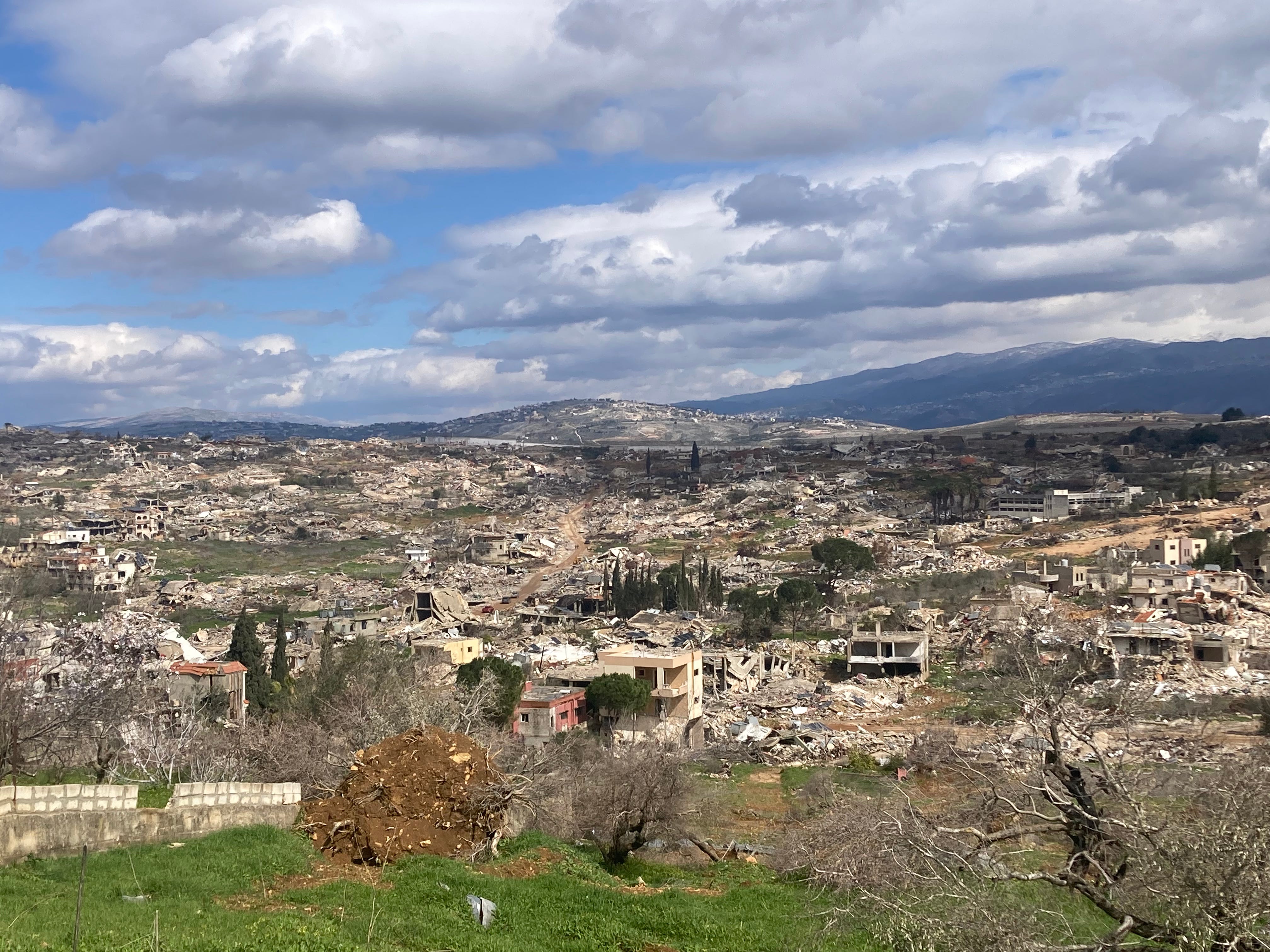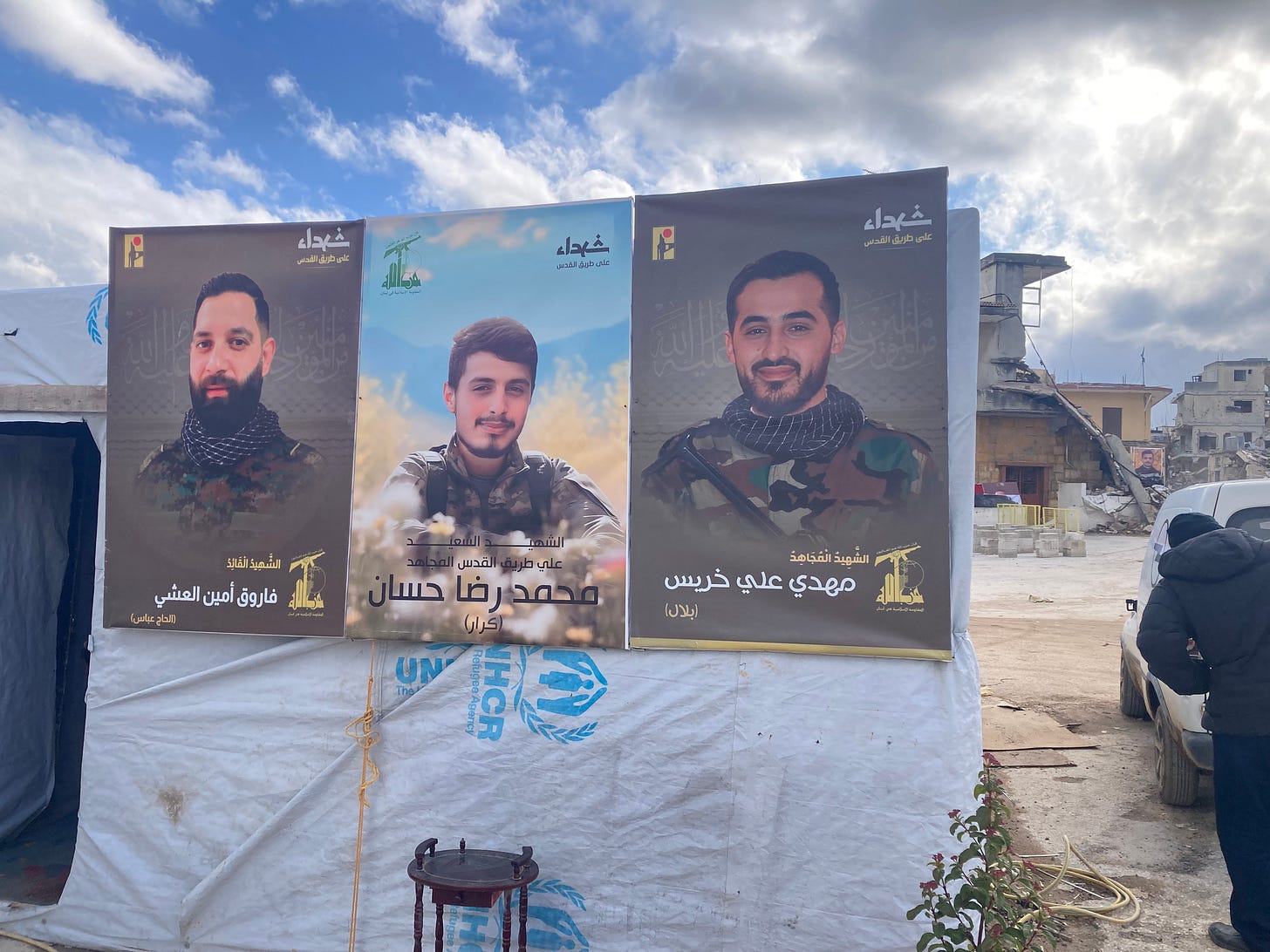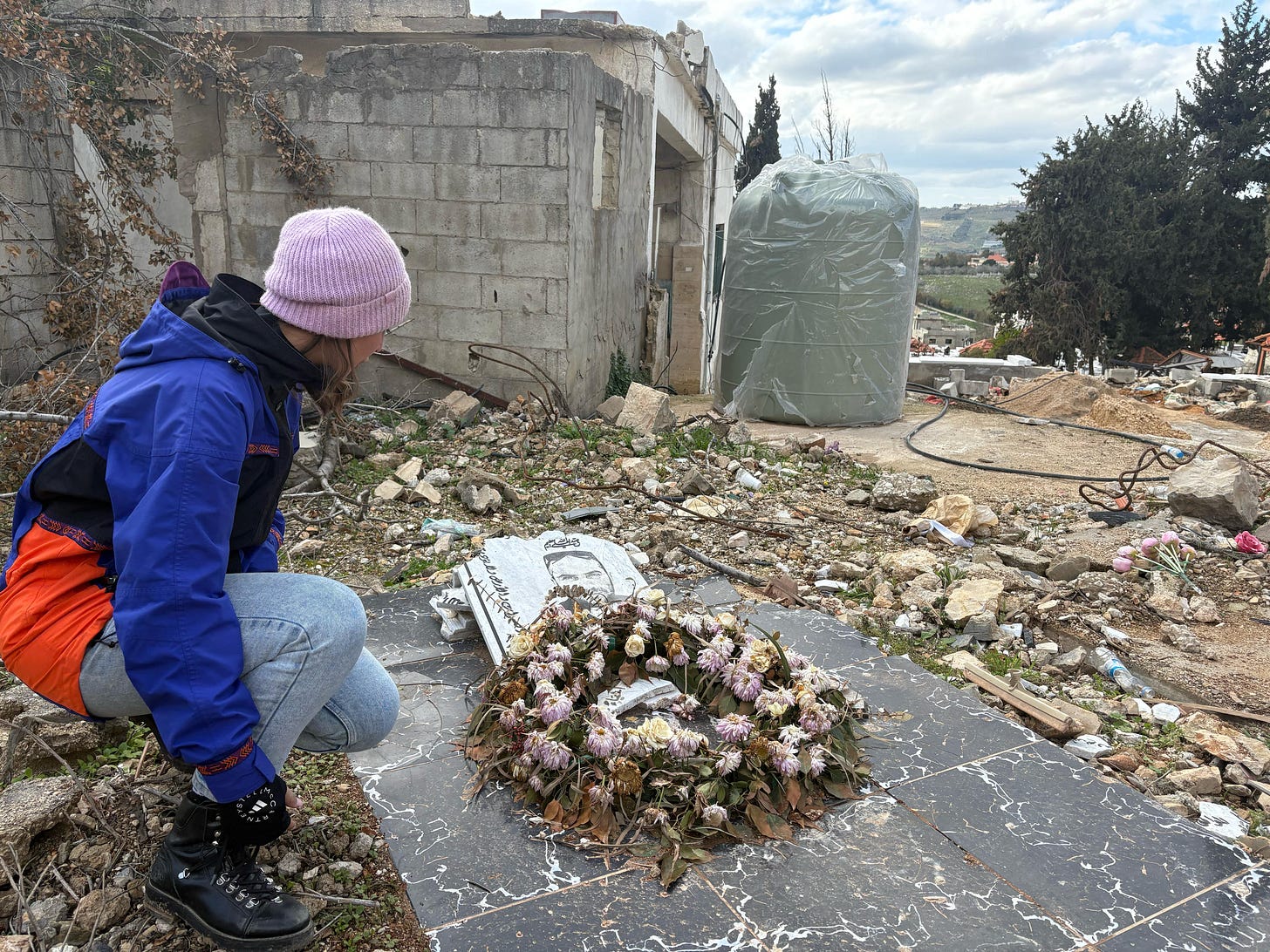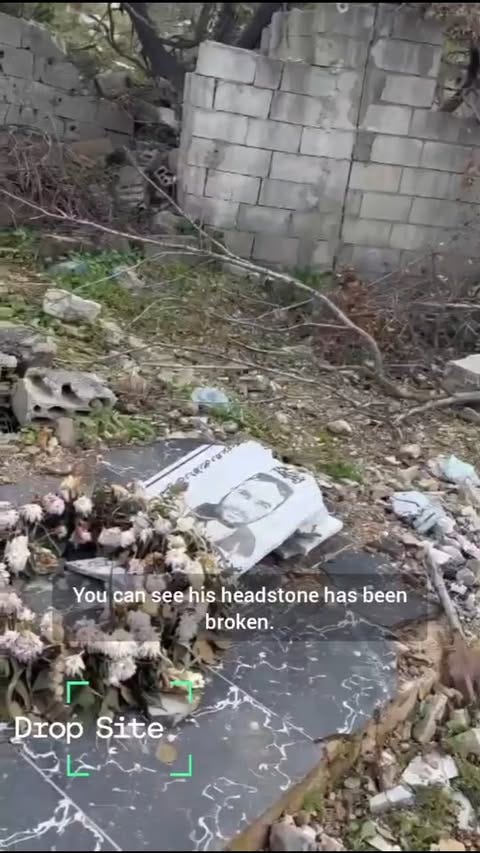The Lebanese Villages Recently Destroyed by Israel
From southern Lebanon, Drop Site's Sharif Abdel Kouddous reports on the gratuitous and total destruction wrought by Israel, much of it since the "ceasefire" began in November.
Drop Site’s Sharif Abdel Kouddous is in Lebanon this weekend, ahead of the highly anticipated funeral of former Hezbollah leader Hassan Nasrallah on Sunday.
On Friday, Sharif was able to go to southern Lebanon, an area from which Israeli troops recently withdrew, to observe the destruction left behind firsthand. This weekend, Drop Site will be reporting from Beirut and Nasrallah’s funeral, providing live updates from the ground. Follow Drop Site on X or Instagram and don’t miss an update.

Kfarkela & Khiam, LEBANON—What was once the village of Kfarkela—nestled along Lebanon’s border with Israel—is now a pile of ruins. Mounds of rubble, twisted rebar, and broken concrete are all that remain where houses once stood. Not a single structure was left untouched by the Israeli troops who had been occupying the area for months. The roads have been demolished; the Israelis bulldozed dirt paths through the middle of the village. As we drove through early on Friday, our driver showed us our route on the map on his phone. “We are driving over where houses once stood,” he said.
The Israeli military withdrew from Kfarkela and several others in southern Lebanon just three days ago, on February 18, after violating a “ceasefire” agreement for withdrawal that expired on January 26. Israeli forces remain illegally stationed inside Lebanon in five locations on hilltops near the border.
On Friday, only a few scattered families were seen standing near the rubble of their homes in an eerie quiet. In the days after January 26, as Drop Site reported previously, displaced residents gathered on the outskirts of the town in protest of the continued Israeli occupation. When they tried to return, Israeli snipers opened fire, killing at least one and wounding over a dozen.
Yet since the Israeli military left the village three days ago, it remains a ghost town. “There’s nothing left,” said Najeeb, a 45-year-old resident standing next to the wreckage of his home where he was born. He politely declined to give his full name. “No houses, no supermarket, no gas station. This is not a war, these are just war crimes.”
Hezbollah began firing rockets and artillery at Israeli forces one day after Israel began its genocidal assault on Gaza. Israel retaliated by bombing Lebanon, mostly in the south. The cross border attacks continued for nearly a year—with over 80% of the strikes coming from Israel. Over 110,000 people in southern Lebanon were displaced from their homes by September, before Israel dramatically escalated the war, carpet bombing large swathes of the country and launching a ground invasion, forcing more than 1.2 million to flee their homes. Over 4,000 people have been killed, including Hezbollah leader Hassan Nasrallah.
Najeeb was displaced from Kfarkela over a year ago and returned for the first time on Wednesday. Despite the total annihilation of his village, he struck a defiant tone. “When I returned, I felt victorious,” he said. “We can replace the stones of our houses. It’s only the land that matters and our presence here.”
Much of the destruction came during the 60-day “ceasefire” between Israel and Lebanon that went into effect on November 27. Troops used bulldozers, dynamite, and artillery to flatten the entire area. “This wasn’t a ceasefire. These agreements are not worth the ink they are printed on,” Najeeb said.
Israeli troops left behind clear signs of their presence. Graffiti scrawled in Hebrew on one home read “Burn”—in the imperative, as if an instruction. Another read “XX was here,” with the name painted over. Another in English read “Israel Forever!” next to a smiley face with yarmulke and side curls. Another further down in the village read “TZAMA is an empire”—an acronym referring to the Israeli engineering corps who are responsible for demolishing large civilian areas using bulldozers and other equipment.
The border with Israel, marked by a thick concrete barrier, lies only a couple hundred yards away from Kfarkela. Red-roofed Israeli settlements directly face the village. Hezbollah’s attacks forced tens of thousands of Israeli settlers to flee northern Israel. And while these settlements were empty they appeared largely unmarked—looking more like casually abandoned summer homes—and stood in stark contrast to the pile of rubble that has become Kfarkela.

A 20-minute drive northeast from Kfarkela lies the town of Khiam. While some buildings are still standing, as much as 70 percent of Khiam has been destroyed. Many of the civilians fled the town nearly a year and a half ago, when the cross-border attacks with Israel first began, though they were able to sporadically return over the ensuing months. When Israel escalated the war in September, civilians were forced to flee but Hezbollah fighters stayed and mounted a fierce resistance, preventing the Israeli military from invading and occupying it. When the ceasefire agreement went into effect in late November and the fighters withdrew, Israeli tanks and troops were finally able to move in.
“Khiam is a town of resistance,” Ali Khreis, a local resident who runs a small lean-to cafe near the center of town, told Drop Site. “The Israelis were unable to enter the town because of the resistance. They were only able to come into Khiam during the ceasefire and that’s when 50 percent of the destruction happened, through demolitions, the burning of houses, shops. Bulldozers plowed right through houses and kept going.”
Khreis’s son, Mahdi, a 33-year-old father of two, was a fighter who was killed on October 29, 2024. A poster of him in military fatigues hangs next to the cafe next to two other fighters, all under the slogan, “Martyrs on the road to Jerusalem.”
“My son was a resistance fighter. He is one of the ones who remained here and fought here. And he was martyred here,” Khreis said. “The occupation didn’t want us to return here but we returned through the blood of our martyrs.”
The attacks in Khiam even extended to the local cemetery, which the Israeli military shelled. Rubble litters the tombstones, some of which have been split apart and exposed. Among those damaged was the grave of Issam Abdallah, a 37-year-old journalist working for Reuters who was killed by Israeli tank fire in a targeted attack on October 13, 2023. The white headstone bearing an image of his face with his sunglasses perched on his head was broken nearly in half. Next to it, the gravestones of his father, grandfather and grandmother sustained even more damage. Someone had propped Issam’s broken headstone on the remaining pieces and laid a wreath of flowers on top.

Khiam showed some signs of life beginning to return. “We are doing what we can and we will return to our hometown,” Khreis said. “We have 30 to 50 families that have returned but mostly on the outskirts of the town because in the middle of the town there are hardly any buildings standing. But some restaurants and cafes have opened, the butcher will open soon. Water will return, electricity too at some point. Step by step we will come back.”
“We made a solidarity front with Gaza, and the Sayyed was martyred,” Khreis said, using the honorific term to refer to Hassan Nasrallah, Hezbollah’s long-serving secretary-general who was assassinated in a massive Israeli air raid on September 27. “Everyone that was martyred here was martyred for Gaza.” Khreis and his family will travel to Beirut to attend Nasrallah’s official funeral ceremony on Sunday where massive crowds are expected.
Lama al-Arian contributed to this report.





More war crimes. Will Natanyahu ever be brought to justice?
The critical question is when will the American people finally raise up and say that enough is enough. With the advent of Trump’s "beautiful" real estate-foreign policy, America keeps getting deeper and deeper. The billionaires supporting Israel are perfectly content spending taxpayer money and they get a big tax-cut just to make it more perverse. Given the moral gravity they attach Israel’s “existence”, let them fund the war machine. It is their “holy-war” after all.
It is clear that America First applies only after Israel is satisfied, which will never happen.
And it is appalling that the most vulnerable Americans lose their Medicaid so that Palestinians lose their lives and billionaires get another multi-trillion-dollar tax-cut. (And, of course, Israel citizens enjoy their free universal healthcare.)